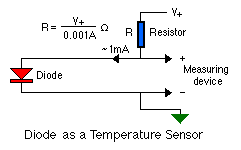The semiconductor (or IC for integrated circuit) temperature sensor is an electronic device fabricated in a similar way to other modern electronic semiconductor components such as microprocessors. Typically hundreds or thousands of devices are formed on thin silicon wafers. Before the wafer is scribed and cut into individual chips, they are usually laser trimmed.
Semiconductor temperature sensors are available from a number of manufacturers. There are no generic types as with thermocouple and RTDs, although a number of devices are made by more than one manufacturer. The AD590 and the LM35 have traditionally been the most popular devices, but over the last few years better alternatives have become available.
These sensors share a number of characteristics – linear outputs, relatively small size, limited temperature range (-40 to +120°C typical), low cost, good accuracy if calibrated but also poor interchangeability. Often the semiconductor temperature sensors are not well designed thermally, with the semiconductor chip not always in good thermal contact with an outside surface. Some devices are inclined to oscillate unless precautions are taken. Provided the limitations of the semiconductor temperature sensors are understood, they can be used effectively in many applications.
The most popular semiconductor temperature sensors are based on the fundamental temperature and current characteristics of the transistor. If two identical transistors are operated at different but constant collector current densities, then the difference in their base-emitter voltages is proportional to the absolute temperature of the transistors. This voltage difference is then converted to a single ended voltage or a current. An offset may be applied to convert the signal from absolute temperature to Celsius or Fahrenheit.
In general, the semiconductor temperature sensor is best suited for embedded applications – that is, for use within equipment. This is because they tend to be electrically and mechanically more delicate than most other temperature sensor types. However they do have legitimate application in many areas, hence their inclusion.
Accuracy of semiconductor sensors
As can be seen from the above information, the “out of the box” or interchangeability accuracy of most semiconductor temperature sensors is not particularly good. In addition the raw sensing element is generally packaged in a standard case for electronic devices, which is less than ideal for precision temperature measurement. However, despite these shortcomings, the sensors are sensitive, reasonably linear and very usable.
If individual sensors are calibrated, significantly better measurement accuracy is possible. Typically, a two point calibration will yield a five-fold better accuracy and a three point calibration will yield a ten-fold improvement over the full temperature range. If the temperature range is limited, even better accuracies are possible. Due to the sensitivity of some sensors, they can be very good in measuring small temperature changes (as opposed to absolute measurement).
Diode Temperature Sensors
The ordinary semiconductor diode may be used as a temperature sensor. The diode is the lowest cost temperature sensor and can produce more than satisfactory results if you are prepared to undertake a two point calibration and provide a stable excitation current. Almost any silicon diode is ok. The forward biased voltage across a diode has a temperature coefficient of about 2.3mV/°C and is reasonably linear. The measuring circuit is simple as shown to the right.

The bias current should be held as constant as possible – using constant current source, or a resistor from a stable voltage source.
Without calibration the initial error is likely to be too large – in the order of ±30°C – the largest of all the contact type temperature sensors. This initial error is greatly reduced if sensor grade parts are used.
One advantage of the diode as a temperature sensor is that it can be electrically robust – tolerant to voltage spikes induced by lightning strike. This is particularly true if power diodes (e.g. the common 1N4004) are used and a second back to back diode is used to limit power dissipation during high peak currents.
The transistor sensor is used in diode mode by connecting the base and collector together. If this is not done, the sensor is wired between base and emitter and the excitation current reduced by a factor of about 100. The result is a very low power, sensitive and linear sensor. The simplicity and performance of the sensor is under valued.
To improve the performance of the diode as a temperature sensor, two diode voltages (V1 and V2) can be measured at different currents (I1 and I2), typically selected to be about 1:10 ratio. The absolute temperature can be calculated from the equation:
$$T = \frac{V1 – V2}{ 8.7248×10^{5} \cdot ln (\frac{ I1}{ I2})}$$
The result is in Kelvins (K). This is the method employed by most integrated circuit temperatures sensors and explains why some output a signal proportional to absolute temperature.
Accuracy of semiconductor sensors
The interchangeability accuracy of most semiconductor temperature sensors is not particularly good. In addition the raw sensing element is generally packaged in a standard case for electronic devices, which is less than ideal for precision temperature measurement (+/- 4 °C for most types). However, despite these shortcomings, the sensors are sensitive, reasonably linear and very usable.
If individual sensors are calibrated, significantly better measurement accuracy is possible. Typically, a two point calibration will yield a five-fold better accuracy and a three point calibration will yield a ten-fold improvement over the full temperature range. If the temperature range is limited, even better accuracies are possible. Due to the sensitivity of some sensors, they can be very good in measuring small temperature changes (as opposed to absolute measurement).
